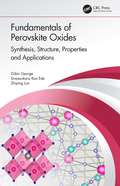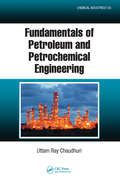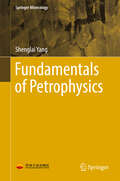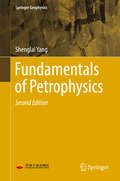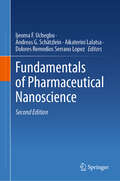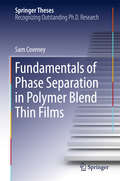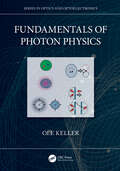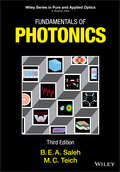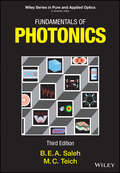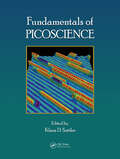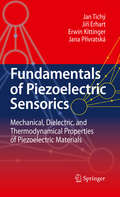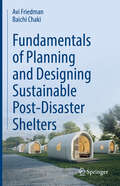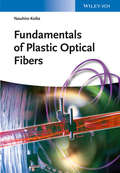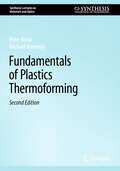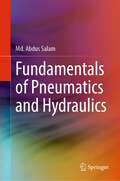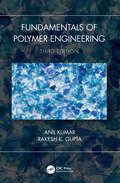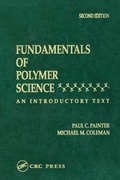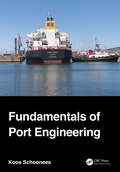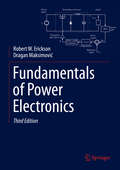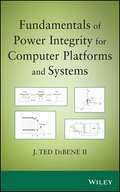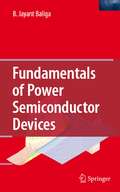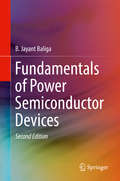- Table View
- List View
Fundamentals of Perovskite Oxides: Synthesis, Structure, Properties and Applications
by Gibin George Sivasankara Rao Ede Zhiping LuoThis textbook entitled Fundamentals of Perovskite Oxides: Synthesis, Structure, Properties and Applications summarizes the structure, synthesis routes, and potential applications of perovskite oxide materials. Since these perovskite-type ceramic materials offer opportunities in a wide range of fields of science and engineering, the chapters are broadly organized into four sections of perovskite-type oxide materials and technology. Covers recent developments in perovskite oxides Serves as a quick reference of perovskite oxides information Describes novel synthesis routes for nanostructured perovskites Discusses comprehensive details for various crystal structures, synthesis methods, properties, and applications Applies to academic education, scientific research, and industrial R&D for materials research in real-world applications like bioengineering, catalysis, energy conversion, energy storage, environmental engineering, and data storage and sensing This book serves as a handy and practical guideline suitable for students, engineers, and researchers working with advanced ceramic materials.
Fundamentals of Petroleum and Petrochemical Engineering (Chemical Industries)
by Uttam Ray ChaudhuriThe supply of petroleum continues to dwindle at an alarming rate, yet it is the source of a range of products- from gasoline and diesel to plastic, rubber, and synthetic fiber. Critical to the future of this commodity is that we learn to use it more judiciously and efficiently. Fundamentals of Petroleum and Petrochemical Engineering provides a holi
Fundamentals of Petrophysics
by Shenglai YangIn this book, the fundamental knowledge involved in petroleum & gas development engineering, such as physical and chemical phenomena, physical processes and the relationship between physical factors is covered. It is arranged into 3 Sections. Section 1 including chapter 1-4 is to introduce the properties of fluids (gases, hydrocarbon liquids, and aqueous solutions). Section II including Chapter 5-7 is to introduce the porous rock properties of reservoir rocks. Section III including Chapter 8-10 is to introduce the mechanism of multiphase fluid flow in porous medium. The book is written primarily to serve professionals working in the petroleum engineering field. It can also be used as reference book for postgraduate and undergraduate students as well for the related oil fields in petroleum geology, oil production engineering, reservoir engineering and enhancing oil recovery.
Fundamentals of Petrophysics
by Shenglai YangIn this book, the fundamental knowledge involved in petroleum & gas development engineering, such as physical and chemical phenomena, physical processes and the relationship between physical factors is covered. It is arranged into 3 Sections. Section 1 including chapter 1-4 is to introduce the properties of fluids (gases, hydrocarbon liquids, and aqueous solutions). Section II including Chapter 5-7 is to introduce the porous rock properties of reservoir rocks. Section III including Chapter 8-10 is to introduce the mechanism of multiphase fluid flow in porous medium. The book is written primarily to serve professionals working in the petroleum engineering field. It can also be used as reference book for postgraduate and undergraduate students as well for the related oil fields in petroleum geology, oil production engineering, reservoir engineering and enhancing oil recovery.
Fundamentals of Pharmaceutical Nanoscience
by Ijeoma F. Uchegbu Andreas G. Schätzlein Aikaterini Lalatsa Dolores Remedios Serrano LopezNanoscience or the science of the very small offers the pharmaceutical scientist a wealth of opportunities. By fabricating at the nanoscale, it is possible to exert unprecedented control on drug activity. This textbook will showcase a variety of nanosystems working from their design and construction to their application in the field of drug delivery. The book is intended for graduate students in drug delivery, physical and polymer chemistry, and applied pharmaceutical sciences courses that involve fundamental nanoscience. The purpose of the text is to present physicochemical and biomedical properties of synthetic polymers with an emphasis on their application in polymer therapeutics i.e., pharmaceutical nanosystems, drug delivery and biological performance. There are two main objectives of this text. The first is to provide advanced graduate students with knowledge of the principles of nanosystems and polymer science including synthesis, structure, and characterization of solution and solid state properties. The second is to describe the fundamentals of therapeutic applications of polymers in drug delivery, targeting, response modifiers as well as regulatory issues. The courses, often listed as Advanced Drug Delivery and Applied Pharmaceutics; Polymer Therapeutics; or Nanomedicine, are designed as an overview of the field specifically for graduate students in the Department of Pharmaceutical Sciences Graduate Programs. However, the course content may also be of interest for graduate students in related biomedical research programs. These courses generally include a discussion of the major principles of polymer science and fundamental concepts of application of polymers as modern therapeutics. All courses are moving away from the above mentioned course names and going by ‘pharmaceutical nanoscience or nanosystems’. This area of research and technology development has attracted tremendous attention during the last twodecades and it is expected that it will continue to grow in importance. However, the area is just emerging and courses are limited but they are offered.
Fundamentals of Phase Separation in Polymer Blend Thin Films
by Sam CoveneyThis work sheds new light on fundamental aspects of phase separation in polymer-blend thin films. A key feature underlying the theoretical models is the unification of one-dimensional thermodynamic phase equilibria with film evolution phenomena in two- and three dimensions. Initially, an established 'phase portrait' method, useful for visualising and calculating phase equilibria of polymer-blend films, is generalised to systems without convenient simplifying symmetries. Thermodynamic equilibria alone are then used to explain a film roughening mechanism in which laterally coexisting phases can have different depths in order to minimise free energy. The phase portraits are then utilised to demonstrate that simulations of lateral phase separation via a transient wetting layer, which conform very well with experiments, can be satisfactorily explained by 1D phase equilibria and a 'surface bifurcation' mechanism. Lastly, a novel 3D model of coupled phase separation and dewetting is developed, which demonstrates that surface roughening shadows phase separation in thin films.
Fundamentals of Photon Physics (Series in Optics and Optoelectronics)
by Ole KellerThe photon, an abstract concept belonging to a global vacuum, only manifests itself duringinteraction with matter. Fundamentals of Photon Physics describes the richly faceted, basic theoryof photon-matter interaction, selecting a wide number of topics. Together with the author’s bookLight -- The Physics of the Photon (CRC, 2014), both written on a scholarly level, the reader isgiven a comprehensive exposition of photon wave mechanics, quantum optics and quantumelectrodynamics (QED).Divided into 10 parts, the book begins by exploring the relation between photon wave mechanicsand quantum field theory. It then describes the theories of zero- and one-photon states andthat of bi-photons. After discussing conservation laws, Lagrangian formulations, geometricphase and topology, the author turns towards the theory of photon scattering, emphasizing adensity matrix operator approach and the role of microscopic extinction theorems. The booknext focuses on mesoscopic QED, devoting particular attention to collective jellium excitationsand photon-spin interactions. Special attention is given to the basics of the photon-magnoninteraction and nonlinear superconductor electrodynamics, including the nonlinear Meissnerrectification phenomenon, before studying the theory of transverse photons tied to (dressing)massive particles.The last three parts take the reader on a journey to topics usually not treated in books on photon-matter interaction. Beginning with photons in curved space-time structures and in spatiallycurved media, e.g. Möbius bands, the author discusses the extension of QED to the electro-weakinteraction at an introductory level. Fundamentals of Photon Physics ends with the establishmentof the set of isovector Maxwell equations in non-Abelian SO(3) gauge theory, leading tothe celebrated hedgehog monopole model.Ole Keller is professor emeritus of theoretical physics at Aalborg University, Denmark. He earned his Licentiate (∼ PhD) degree in semiconductor physics from the Danish Technical University in Copenhagen in 1972, and the Doctor of Science degree from the University of Aarhus (1996). In 1989 he was appointed as the first professor in physics at Aalborg University by Margrethe Den Anden, queen of Denmark. The same year he was admitted to Kraks Blaa Bog, a prestigious Danish biographical dictionary which (citatum) ”Includes men and women, whose life story could have an interest for a wider public”. He is a fellow of the Optical Society of America.He has written the books entitled Quantum Theory of Near-Field Electrodynamics (Springer, 2011) and LIGHT - The Physics of the Photon (CRC, 2014), as well as the monographs Local Fields in the Electrodynamics of Mesoscopic Media (Physics Reports, 1996) and On the Theory of Spatial Localization of Photons (Physics Reports, 2005). He is the editor of the books Nonlinear Optics in Solids (Springer, 1990), Studies in Classical and Quantum Nonlinear Optics (Nova Science, 1995) and Notions and Perspectives of Nonlinear Optics (World Scientific, 1996).In recent years he has carried out theoretical research in fundamental photon physics, microscopic few-photon diffraction, mesoscopic and Möbius band electrodynamics, and studied magnetic monopole theory based on QED and the isovector Maxwell equations in non-Abelian gauge symmetry.
Fundamentals of Photonics (Wiley Series in Pure and Applied Optics #32)
by Bahaa E. Saleh Malvin Carl TeichFundamentals of Photonics A complete, thoroughly updated, full-color third edition Fundamentals of Photonics, Third Edition is a self-contained and up-to-date introductory-level textbook that thoroughly surveys this rapidly expanding area of engineering and applied physics. Featuring a blend of theory and applications, coverage includes detailed accounts of the primary theories of light, including ray optics, wave optics, electromagnetic optics, and photon optics, as well as the interaction of light and matter. Presented at increasing levels of complexity, preliminary sections build toward more advanced topics, such as Fourier optics and holography, photonic-crystal optics, guided-wave and fiber optics, LEDs and lasers, acousto-optic and electro-optic devices, nonlinear optical devices, ultrafast optics, optical interconnects and switches, and optical fiber communications. The third edition features an entirely new chapter on the optics of metals and plasmonic devices. Each chapter contains highlighted equations, exercises, problems, summaries, and selected reading lists. Examples of real systems are included to emphasize the concepts governing applications of current interest. Each of the twenty-four chapters of the second edition has been thoroughly updated.
Fundamentals of Photonics (Wiley Series in Pure and Applied Optics #32)
by Bahaa E. Saleh Malvin Carl TeichFundamentals of Photonics A complete, thoroughly updated, full-color third edition Fundamentals of Photonics, Third Edition is a self-contained and up-to-date introductory-level textbook that thoroughly surveys this rapidly expanding area of engineering and applied physics. Featuring a blend of theory and applications, coverage includes detailed accounts of the primary theories of light, including ray optics, wave optics, electromagnetic optics, and photon optics, as well as the interaction of light and matter. Presented at increasing levels of complexity, preliminary sections build toward more advanced topics, such as Fourier optics and holography, photonic-crystal optics, guided-wave and fiber optics, LEDs and lasers, acousto-optic and electro-optic devices, nonlinear optical devices, ultrafast optics, optical interconnects and switches, and optical fiber communications. The third edition features an entirely new chapter on the optics of metals and plasmonic devices. Each chapter contains highlighted equations, exercises, problems, summaries, and selected reading lists. Examples of real systems are included to emphasize the concepts governing applications of current interest. Each of the twenty-four chapters of the second edition has been thoroughly updated.
Fundamentals of Picoscience
by Klaus D. SattlerUshering in the next technological era, this state-of-the-art book focuses on the instrumentation and experiments emerging at the picometer scale. International scientists and researchers at the forefront of the field address the key challenges in developing new instrumentation and techniques to visualize and measure structures at this sub-nanometer level. The book helps you understand how picoscience is an extension of nanoscience, determine which experimental technique to use in your research, and connect basic studies to the development of next-generation picoelectronic devices.
Fundamentals of Piezoelectric Sensorics
by Jirí Erhart Erwin Kittinger Jana Prívratská Jan TichýPresents the fundamental physics of piezoelectric sensors. Only book with this scope Targeted to those engineers, phycisists and chemists who are involved in materials processing, device design and manufacturing.
Fundamentals of Planning and Designing Sustainable Post-Disaster Shelters
by Avi Friedman Baichi ChakiThe book explores essential principles and practices for planning and designing sustainable refugee shelters. With millions of people forced to flee their homes annually due to conflict, environmental disasters, or persecution, the urgency of this global crisis cannot be overstated. Since refugees often reside in temporary shelters for years after years, it is imperative to construct refugee camps and shelters that address their long-term needs. This comprehensive guide delves into emergency shelter design and refugee camp planning concepts, exploring topics ranging from site selection and infrastructure development to shelter design and material choice. Drawing on real-world case studies and expert insights, this book offers a vital resource for architects, urban planners, humanitarian aid workers, policymakers, researchers, and students. As climate change exacerbates the refugee crisis, it becomes increasingly imperative to prioritize innovative, sustainable solutions for development and foster resilience.
Fundamentals of Plastic Optical Fibers
by Yasuhiro KoikePolymer photonics is an interdisciplinary field which demands excellence both in optics (photonics) and materials science (polymer). However, theses disciplines have developed independently, and therefore the demand for a comprehensive work featuring the fundamentals of photonic polymers is greater than ever. This volume focuses on Polymer Optical Fiber and their applications. The first part of the book introduces typical optical fibers according to their classifications of material, propagating mode, and structure. Optical properties, the high bandwidth POF and transmission loss are discussed, followed by an outline on the propagating mode characteristics and how they affect the performances of the fiber. The second part of the book reviews conventional materials of POFs and gives an overview on fabrication methods. This is followed by a survey of characterization methods. Based on the characteristics of optical communication systems, the last chapter will concentrate on the many advantages of POF in link and network design. Written by a top expert in the field, this is an invaluable resource for semiconductor physicists, materials scientists, polymer chemists, electrical engineers, and those working in the semiconductor industry.
Fundamentals of Plastics Thermoforming (Synthesis Lectures on Materials and Optics)
by Michael Kennedy Peter KleinThis second edition serves as a foundational guide to plastics thermoforming, covering the essential topics of the industry today. The authors take a process application approach to the topic, rather than focusing on theory. The book explains materials and processes, as well as part and tool design. This second edition includes thorough discussion of green plastics within an expanded chapter on environmental issues. The authors also cover quality control, which is critical to any operation. The book provides information about actual products and processes with the intent of understanding practical issues in the industry, which makes the book a valuable resource for students and professionals in the field of thermoforming, including manufacturing, managers, process engineers, and quality engineers. This second edition expands upon the original book and brings it up to date with additional data and key updates.
Fundamentals of Pneumatics and Hydraulics
by Md. Abdus SalamThis book covers the basics of DC circuits, AC circuits, three-phase power to understand the basics and controls of electro-hydraulics and electro-pneumatics. This book covers detailed knowledge on the fluid power properties, Bernoulli’s equation, Torricelli’s theorem, viscosity, viscosity index, hydraulic pumps, hydraulic valves, hydraulic motors, pressure control valves, pneumatic systems, pneumatic cylinders, different types of gas laws, valve actuation, relay, magnetic contactor, different types of switches, logic gates, electro-pneumatic control circuits with different options and introduction to PLC. In addition, the detailed technique of Automation Studio software, different types of simulation circuits with hydraulics, pneumatics and electro-pneumatic are included. This book will be an excellent textbook for electromechanical, robotics, mechatronics, electrical control and mechanical students as well as for the professional who practices fluid power systems.
Fundamentals of Polymer Engineering (Plastics Engineering #66)
by Anil Kumar Rakesh K. Gupta<p>Exploring the chemistry of synthesis, mechanisms of polymerization, reaction engineering of step-growth and chain-growth polymerization, polymer characterization, thermodynamics and structural, mechanical, thermal and transport behavior of polymers as melts, solutions and solids, Fundamentals of Polymer Engineering, Third Edition covers essential concepts and breakthroughs in reactor design and polymer production and processing. It contains modern theories and real-world examples for a clear understanding of polymer function and development. This fully updated edition addresses new materials, applications, processing techniques, and interpretations of data in the field of polymer science. It discusses the conversion of biomass and coal to plastics and fuels, the use of porous polymers and membranes for water purification, and the use of polymeric membranes in fuel cells. Recent developments are brought to light in detail, and there are new sections on the improvement of barrier properties of polymers, constitutive equations for polymer melts, additive manufacturing and polymer recycling. <p>This textbook is aimed at senior undergraduate students and first year graduate students in polymer engineering and science courses, as well as professional engineers, scientists, and chemists. Examples and problems are included at the end of each chapter for concept reinforcement.</p>
Fundamentals of Polymer Science for Engineers
by Stoyko FakirovFilling a gap in the market, this textbook provides a concise, yet thorough introduction to polymer science for advanced engineering students and practitioners, focusing on the chemical, physical and materials science aspects that are most relevant for engineering applications. After covering polymer synthesis and properties, the major section of the book is devoted to polymeric materials, such as thermoplastics and polymer composites, polymer processing such as injection molding and extrusion, and methods for large-scale polymer characterization. The text concludes with an overview of engineering plastics. The emphasis throughout is on application-relevant topics, and the author focuses on real-life, industry-relevant polymeric materials.
Fundamentals of Polymer Science: An Introductory Text, Second Edition
by Michael M. ColemanNow in its second edition, this widely used text provides a unique presentation of today's polymer science. It is both comprehensive and readable. The authors are leading educators in this field with extensive background in industrial and academic polymer research. The text starts with a description of the types of microstructures found in polymer
Fundamentals of Polymer-Clay Nanocomposites
by Gary W. Beall Clois E. PowellWritten for graduate students, researchers, and practitioners, this book provides a complete introduction to the science, engineering, and commercial applications of polymer-clay nanocomposites. Starting with a discussion of general concepts, the authors define specific terms used in the field, providing newcomers with a strong foundation to the area. The physical and mechanical properties of polymer-clay nanocomposites are then described, with chapters on thermodynamics and kinetics, engineering properties, barrier properties, and flame retardancy. Mechanisms underpinning observed effects, such as UV resistance, solvent resistance, and hardness, are also explained. In-depth discussions of clay and clay surface treatment, fabrication, and characterization of nanocomposites are provided, and particular emphasis is placed on the proper use and interpretation of analytical techniques, helping readers to avoid artifacts in their own work. With commercial applications discussed throughout, and experimental results connected with theory, this is an ideal reference for those working in polymer science.
Fundamentals of Port Engineering
by Koos SchooneesPort engineering primarily deals with the design, construction, operation, management, and maintenance of ports, overlapping with many other disciplines. This book provides an introductory text to prospective (graduate) port engineers and presents a wide variety of port subjects for practicing engineers. It covers almost all topics related to port engineering in a fundamental way, including dredging, marine aids to navigation, environmental issues, containers, liquid bulk, dry bulk, general cargo, multipurpose, roll-on/roll-off (Ro-Ro), fishing, and ferry terminals. Discussions are targeted at a conceptual design level. Other features: • Aspects of port engineering are discussed, including shipping, maritime trade, environmental aspects (such as climate change), resilience of ports, nature-based solutions, and port management (such as security, equipment, slurry pumping, and so forth).• Illustrates the design of port terminals.• Discusses site selection for a new port, the factors to be considered, and ways to compare different potential port sites.• Explores asset management and repair of marine structures.• Includes case studies from around the world, examples, and practical and user-friendly guidelines.
Fundamentals of Power Electronics
by Dragan Maksimović Robert W. EricksonFundamentals of Power Electronics, Third Edition, is an up-to-date and authoritative text and reference book on power electronics. This new edition retains the original objective and philosophy of focusing on the fundamental principles, models, and technical requirements needed for designing practical power electronic systems while adding a wealth of new material. Improved features of this new edition include: new material on switching loss mechanisms and their modeling; wide bandgap semiconductor devices; a more rigorous treatment of averaging; explanation of the Nyquist stability criterion; incorporation of the Tan and Middlebrook model for current programmed control; a new chapter on digital control of switching converters; major new chapters on advanced techniques of design-oriented analysis including feedback and extra-element theorems; average current control; new material on input filter design; new treatment of averaged switch modeling, simulation, and indirect power; and sampling effects in DCM, CPM, and digital control. Fundamentals of Power Electronics, Third Edition, is intended for use in introductory power electronics courses and related fields for both senior undergraduates and first-year graduate students interested in converter circuits and electronics, control systems, and magnetic and power systems. It will also be an invaluable reference for professionals working in power electronics, power conversion, and analog and digital electronics.
Fundamentals of Power Integrity for Computer Platforms and Systems
by Joseph T. Dibene IIAn all-encompassing text that focuses on the fundamentals of power integrityPower integrity is the study of power distribution from the source to the load and the system level issues that can occur across it. For computer systems, these issues can range from inside the silicon to across the board and may egress into other parts of the platform, including thermal, EMI, and mechanical.With a focus on computer systems and silicon level power delivery, this book sheds light on the fundamentals of power integrity, utilizing the author's extensive background in the power integrity industry and unique experience in silicon power architecture, design, and development. Aimed at engineers interested in learning the essential and advanced topics of the field, this book offers important chapter coverage of fundamentals in power distribution, power integrity analysis basics, system-level power integrity considerations, power conversion in computer systems, chip-level power, and more.Fundamentals of Power Integrity for Computer Platforms and Systems:Introduces readers to both the field of power integrity and to platform power conversionProvides a unique focus on computer systems and silicon level power delivery unavailable elsewhereOffers detailed analysis of common problems in the industryReviews electromagnetic field and circuit representationIncludes a detailed bibliography of references at the end of each chapterWorks out multiple example problems within each chapterIncluding additional appendixes of tables and formulas, Fundamentals of Power Integrity for Computer Platforms and Systems is an ideal introductory text for engineers of power integrity as well as those in the chip design industry, specifically physical design and packaging.
Fundamentals of Power Semiconductor Devices
by B. Jayant BaligaFundamentals of Power Semiconductor Devices provides an in-depth treatment of the physics of operation of power semiconductor devices that are commonly used by the power electronics industry. Analytical models for explaining the operation of all power semiconductor devices are shown. The treatment here focuses on silicon devices but includes the unique attributes and design requirements for emerging silicon carbide devices. The book will appeal to practicing engineers in the power semiconductor device community.
Fundamentals of Power Semiconductor Devices
by B. Jayant BaligaFundamentals of Power Semiconductor Devices provides an in-depth treatment of the physics of operation of power semiconductor devices that are commonly used by the power electronics industry. Analytical models for explaining the operation of all power semiconductor devices are shown. The treatment here focuses on silicon devices but includes the unique attributes and design requirements for emerging silicon carbide devices. The book will appeal to practicing engineers in the power semiconductor device community.
Fundamentals of Power System Economics
by Daniel S. Kirschen Goran StrbacA new edition of the classic text explaining the fundamentals of competitive electricity markets—now updated to reflect the evolution of these markets and the large scale deployment of generation from renewable energy sources The introduction of competition in the generation and retail of electricity has changed the ways in which power systems function. The design and operation of successful competitive electricity markets requires a sound understanding of both power systems engineering and underlying economic principles of a competitive market. This extensively revised and updated edition of the classic text on power system economics explains the basic economic principles underpinning the design, operation, and planning of modern power systems in a competitive environment. It also discusses the economics of renewable energy sources in electricity markets, the provision of incentives, and the cost of integrating renewables in the grid. Fundamentals of Power System Economics, Second Edition looks at the fundamental concepts of microeconomics, organization, and operation of electricity markets, market participants’ strategies, operational reliability and ancillary services, network congestion and related LMP and transmission rights, transmission investment, and generation investment. It also expands the chapter on generation investments—discussing capacity mechanisms in more detail and the need for capacity markets aimed at ensuring that enough generation capacity is available when renewable energy sources are not producing due to lack of wind or sun. Retains the highly praised first edition’s focus and philosophy on the principles of competitive electricity markets and application of basic economics to power system operating and planning Includes an expanded chapter on power system operation that addresses the challenges stemming from the integration of renewable energy sources Addresses the need for additional flexibility and its provision by conventional generation, demand response, and energy storage Discusses the effects of the increased uncertainty on system operation Broadens its coverage of transmission investment and generation investment Updates end-of-chapter problems and accompanying solutions manual Fundamentals of Power System Economics, Second Edition is essential reading for graduate and undergraduate students, professors, practicing engineers, as well as all others who want to understand how economics and power system engineering interact.
